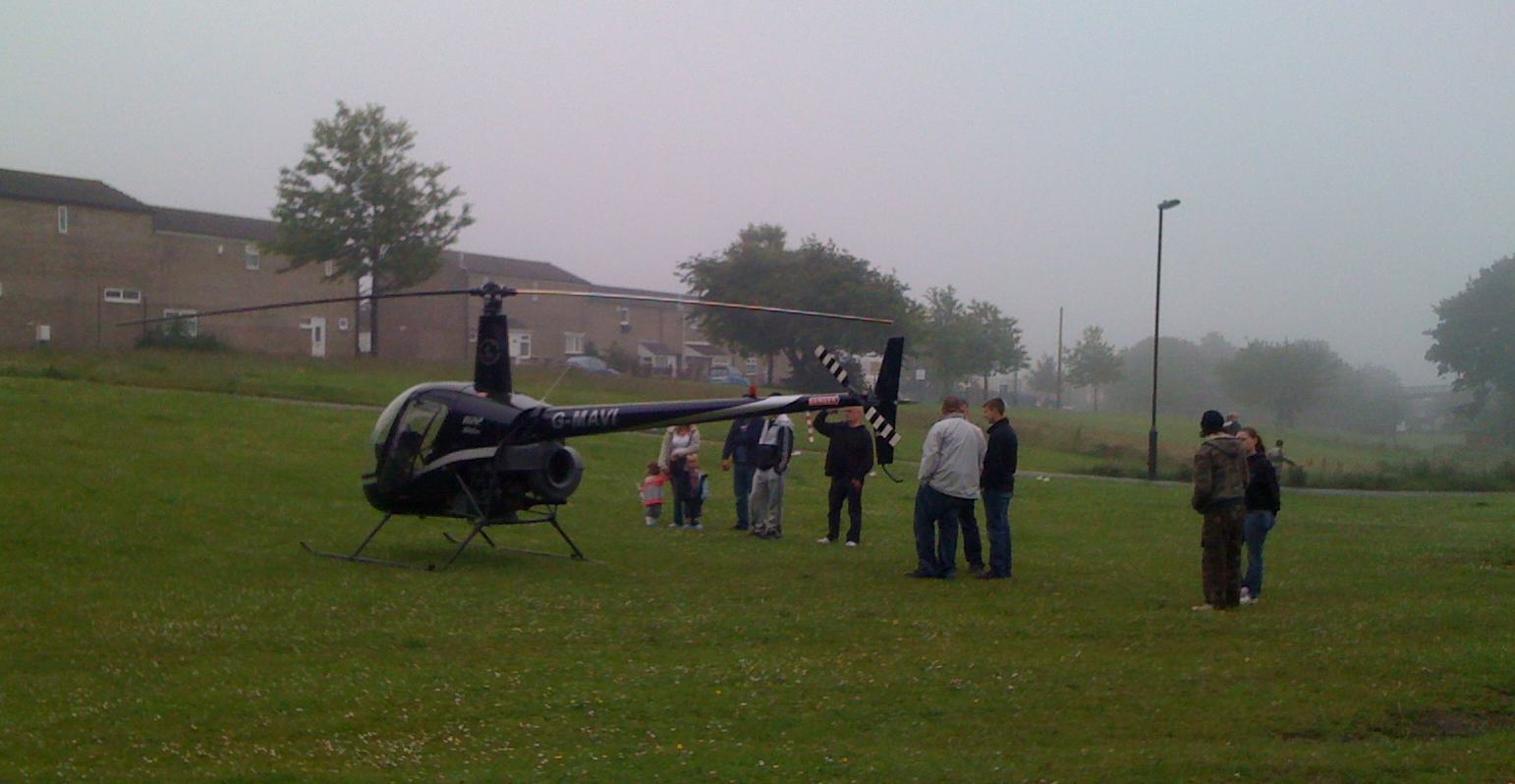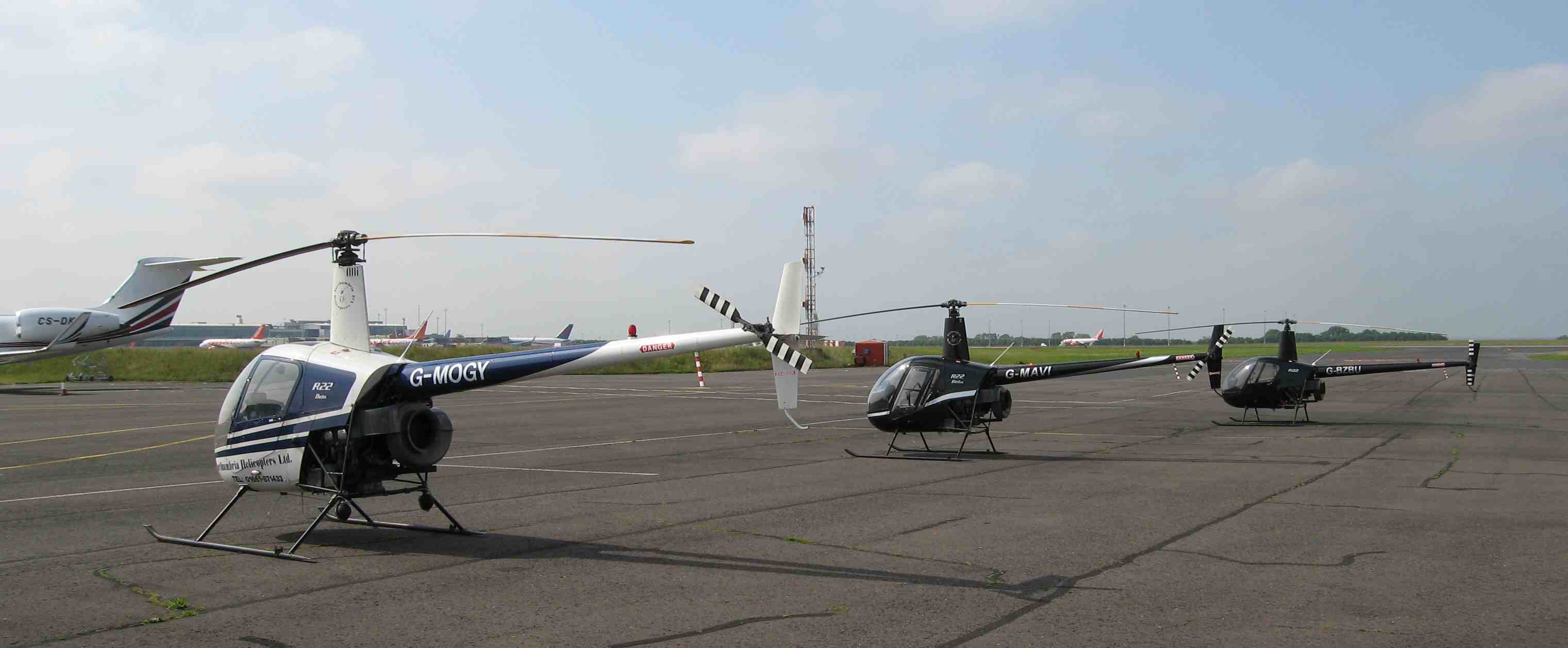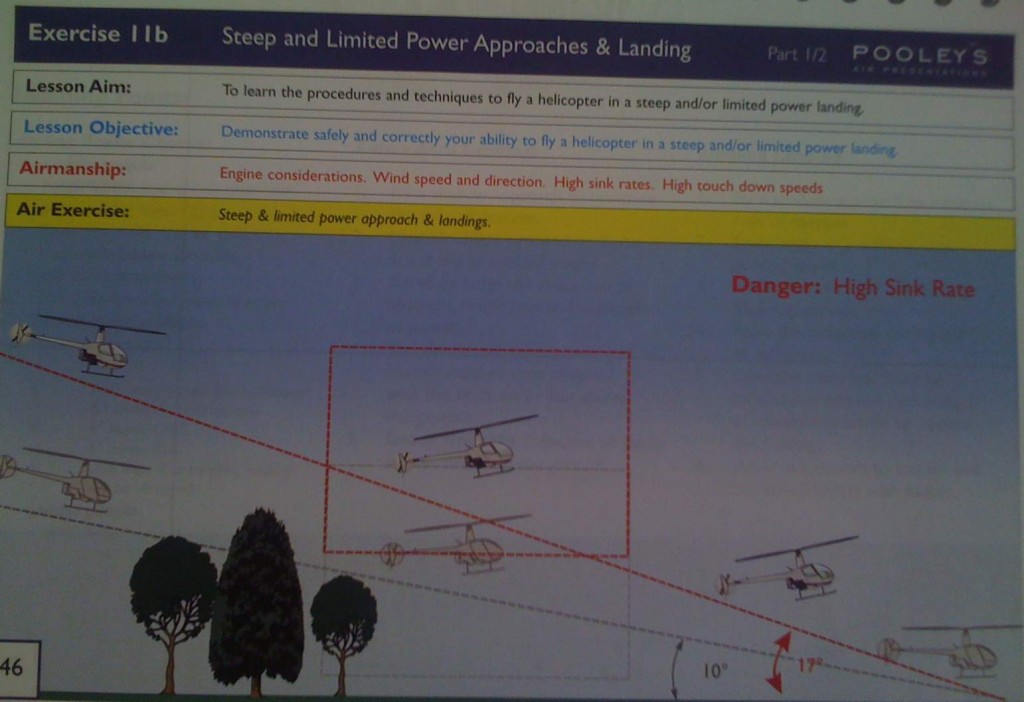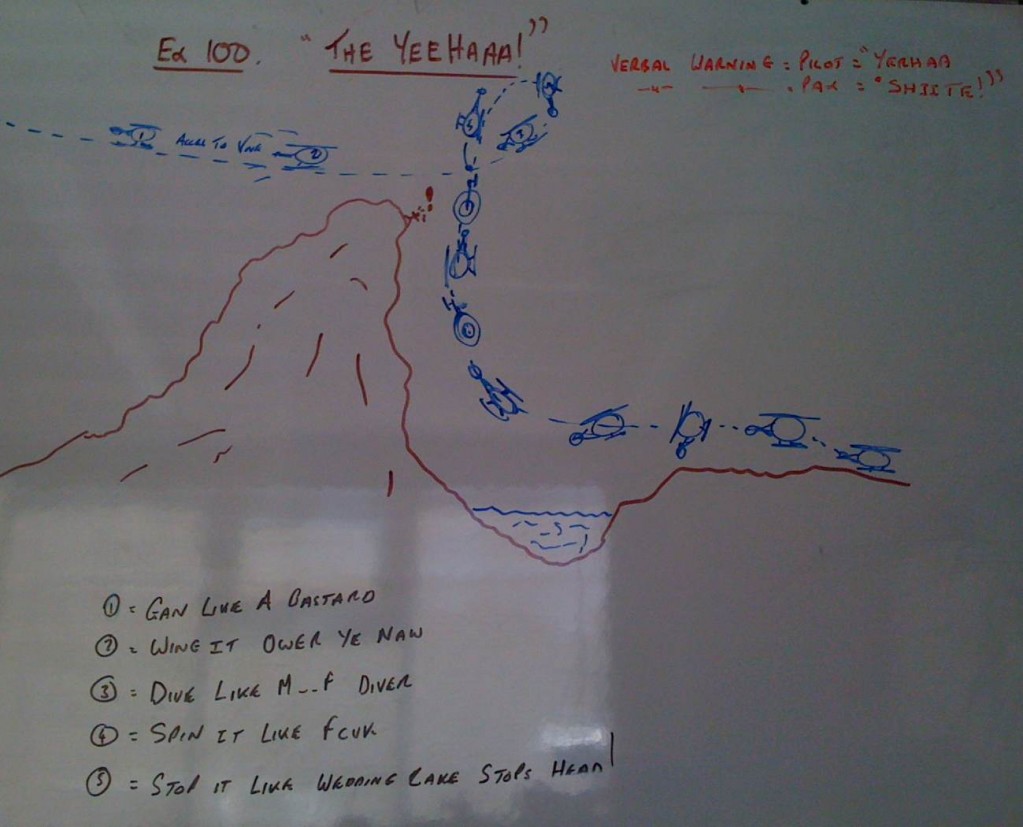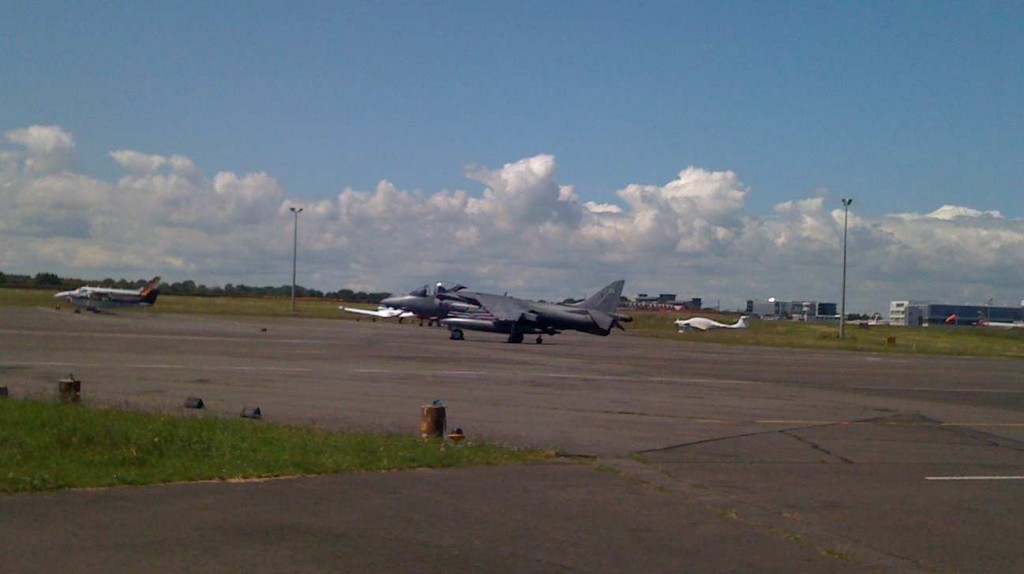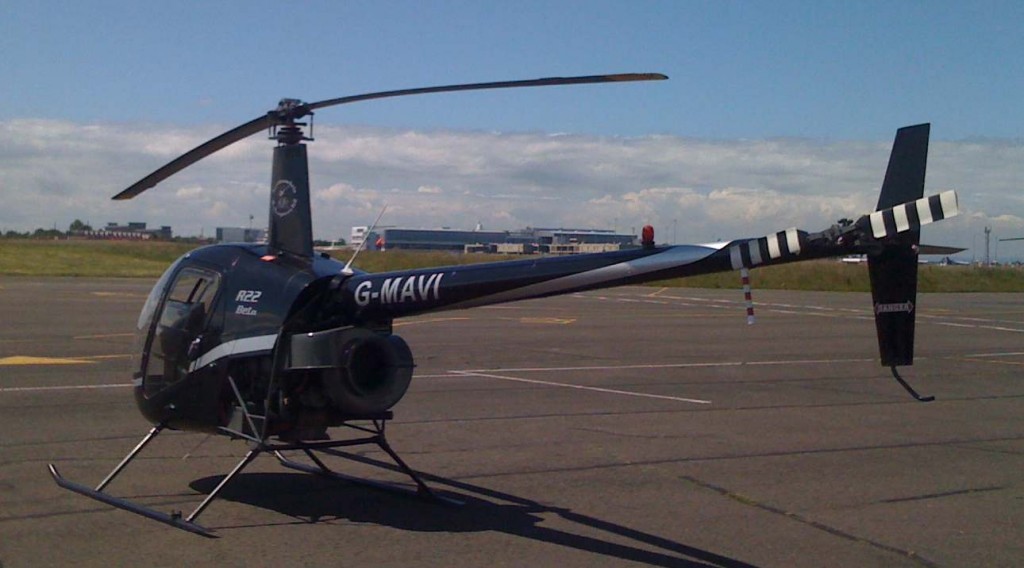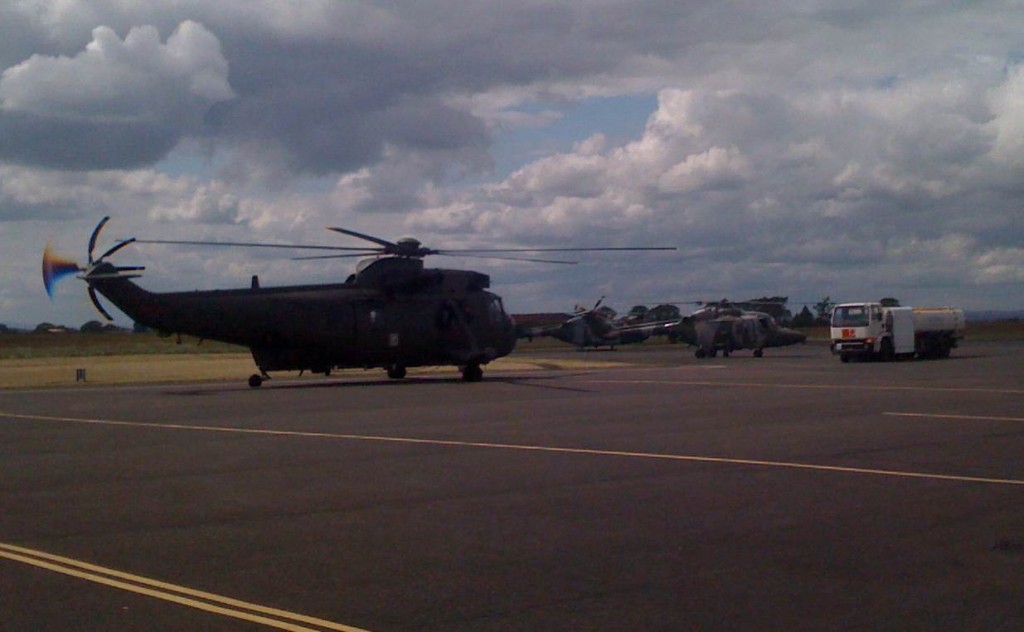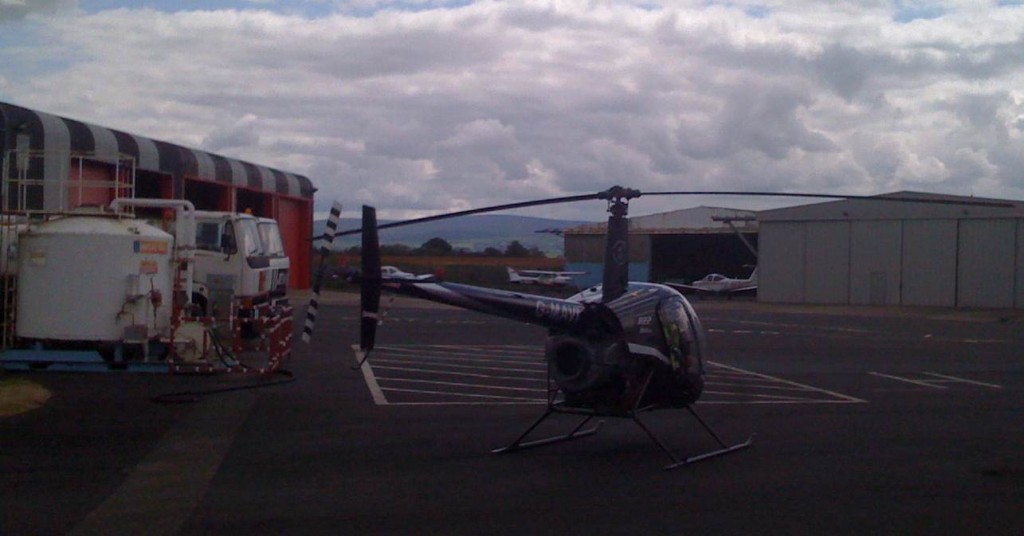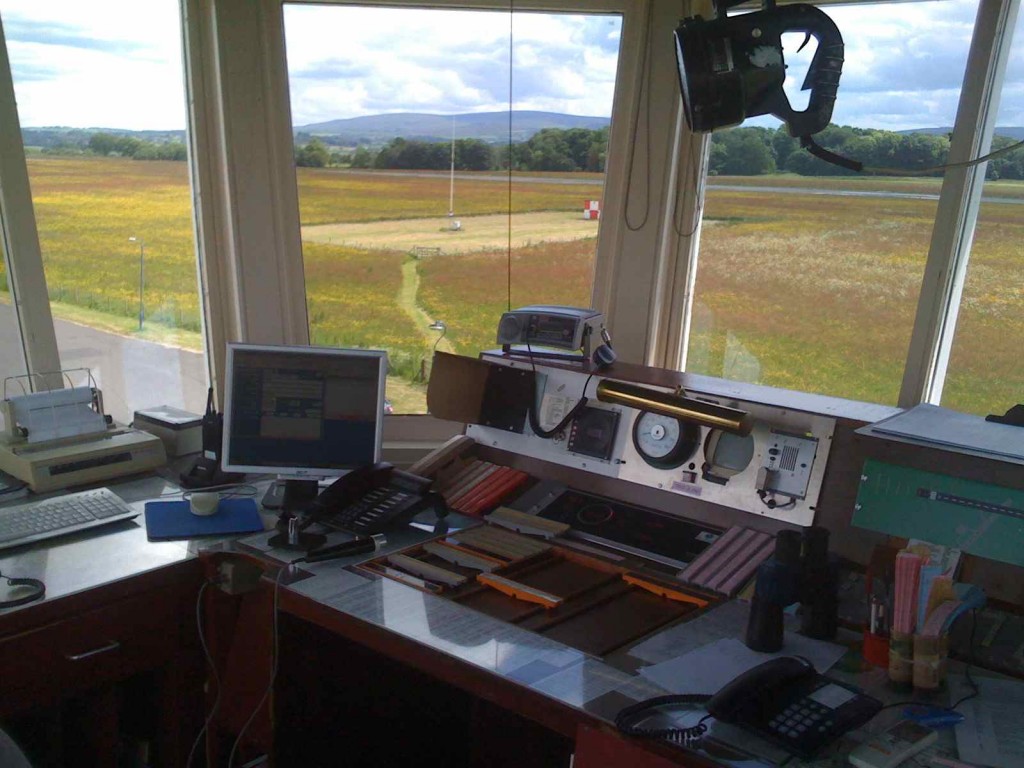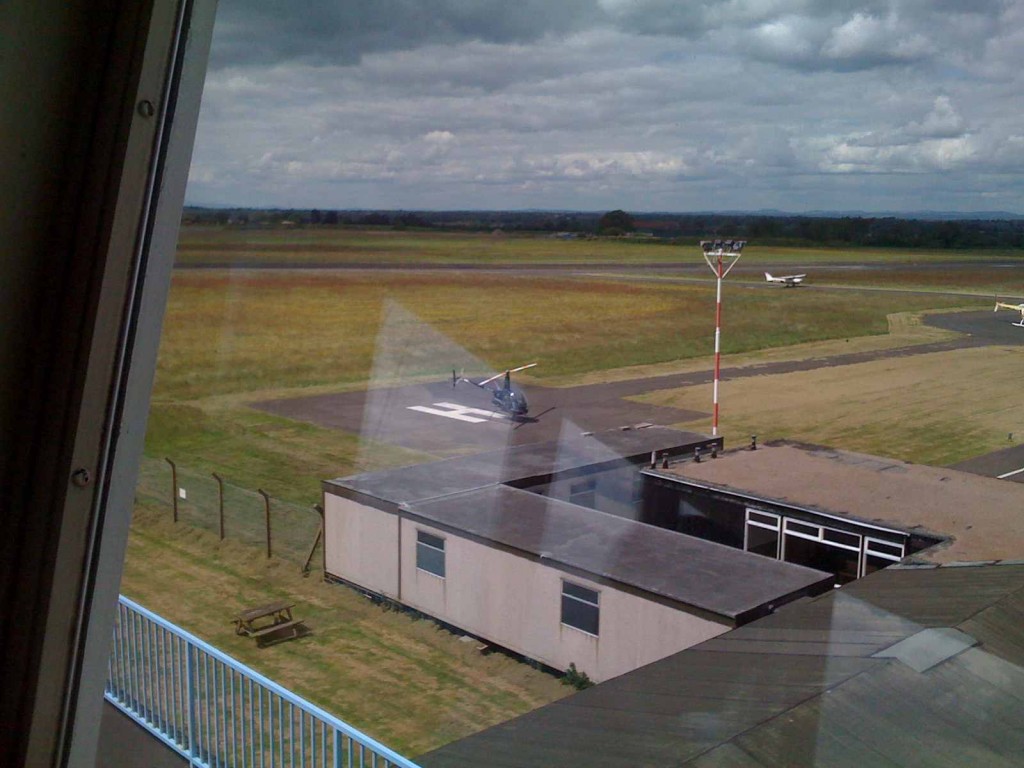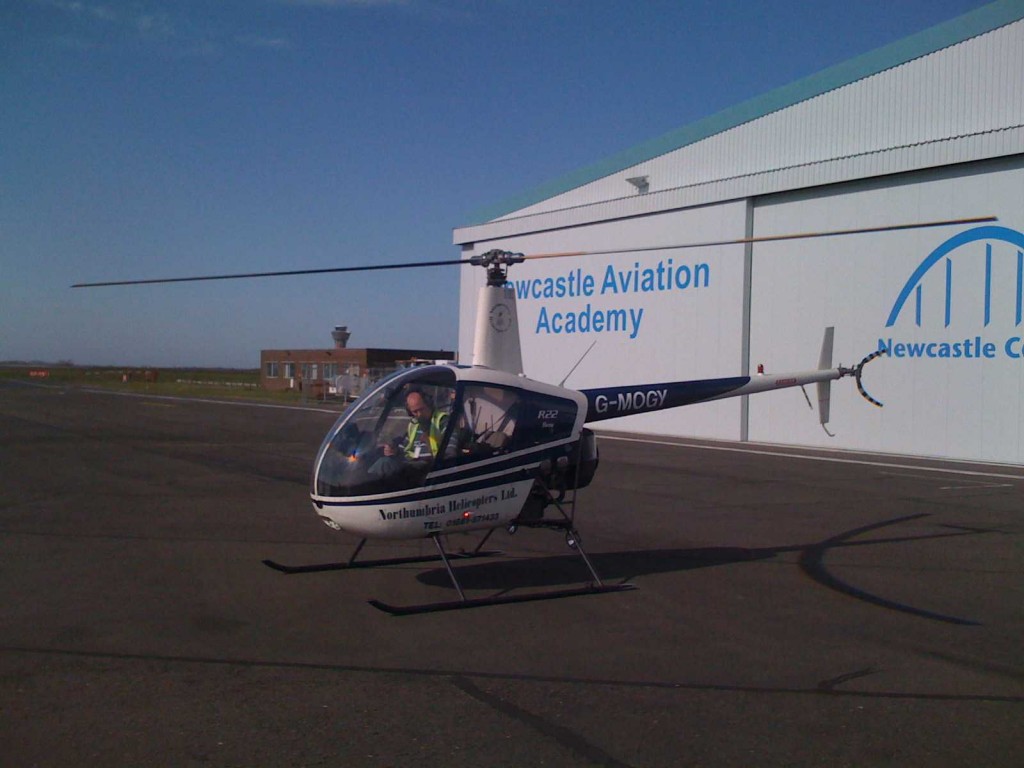Lesson 14 – 26th June 2009 – 1115 – 1hr 00mins – Total so far – 14hours 45min
Lesson 15 – 26th June 2009 – 1300 – 1hr 48mins – Total so far – 16hours 33min
Well, today has been one of the most exciting days of my life and a huge learning experience, and not for the solo flight.
The day started off with a full cross country plan of the route to Carlisle. We worked out the headings to fly and how long to fly them. Scott came to help at one point, with a view how to plan it for the final exam to tick all the boxes. I went to do the checks and put some oil in G-MAVI. We had fuel for 2 hours and were good to go.
Once I’d started her up and got us nearly ready for the off, Steve came out and we did the final checks and we were on our way. Hold at Foxtrot, 07 takeoff, left turn after the fire station, and our first track of 310′ to the North of Ponteland (2 minutes). The weather was great at this point, although not quite great enough to fly the 1800′ we had planned, so we were down at 1400′.
Next was a 6-mile 272′ track to Stagshaw Masts and that went fine too. Finally the 17 mile 263′ track to Carlisle. I lost the heading by a few degrees quite a few times, but at our half-way point we were bang on where we should be, and with a nice tail-wind, we made Carlisle 25 minutes after departure from Newcastle. We then proceeded to do 35 minutes of circuits and autorotations, with me doing the last couple of circuits totally without input from Steve. I was pleased with my liftoffs, they had really improved, and they felt very smooth, and my circuits were generally ok. Not perfect 90′ turns and also, I forgot Carburettor Heat once and Steve gave a few coughs, and when they weren’t subtle enough, he looked down at the Carb Heat knob, and as I was concentrating so hard, I still didn’t get it, but when I did I was laughing !
So, with the circuits done, we taxi’ed to the fuel pump and while Mr Fuel Pump man filled her up, we went for a bacon buttie in Carlisle’s excellent little cafe. Cracking little airport Carlisle, scenery and wildlife (in the form of birds) are amazing !
Once we were refreshed, we checked the weather for Newcastle and it seemed to be getting worse, so Steve contacted another student who was going to come to Carlisle (Rupert) for some lessons to abort his lesson, so we could do what we had to do and then return before it got too bad. Weather-wise at that time, it was good for a return to Newcastle.
So, started Lesson 15, a Lesson I will never forget and probably the lesson I have learned the most valuable lessons from. Steve too I think.
So, I’m doing all the flying unless I say otherwise. Liftoff from the pump, taxi past Bravo to the grass hover triangle and then a few more circuits where Steve kept schtum. All good. One more autorotation (just in case the engine failed), I only entered it, Steve controlled the rotor speed and the final powered recovery. And then one last thing, before I went solo, we practiced an engine failure in the hover. We did about 3 of these, but Steve did them all, while I followed through. The way it works, we’re in the hover, Steve cuts the throttle, we apply pedal to counter the loss of torque and then a final pull on the collective to cushion the landing. Pedal-Something-Cushion. Pedal-Maintain stability-Cushion, something like that. Steve’ll remind me when I see him next.
So, with that done, it was solo time. I was as excited as a pig in sh+t. Gagging for it. So excited, I had forgot that the camera I had brought to ask Steve to record the moment for the blog was under the seat I was sitting on. Thankfully, Steve said he’d record it on his phone, which he did. So when I get the footage, I’ll post it on the blog. I reviewed it afterwards and some of it was great. He got my final landing and approached the copter with his camera video’ing and got the biggest smile on my face I have ever seen. The grin never ended. Can’t wait to see it again.
The solo’s were uneventful. Steve had said to do a circuit and if I felt comfortable with it, to do another couple if I wanted. He said not to worry about the spot turns, and just do 90′ turns to check we were clear, but I wanted to do them. He warned me that the heli would handle differently because of the different CoG. It did, the nose tended to lift up more if i recall correctly. I think the first liftoff was the worst, I seemed to spin round about 70 degrees, before I caught it, but once I’d sussed the differences, I was really pleased with how the 3 circuits went. A couple of the landings I did I was over the moon with, but the first one felt different (again, because of the CoG difference I suppose).
I didn’t forget Carb Heat once – result !
There were 3 helicopters doing flights around the airport at the time I was doing my solo. One taxi’ing, one inbound from the west.
Some nice R/T from when I was doing my solo bit….
Tower :- Callsign, Approach from the west, caution the Robinson Helicopter doing his first solo left hand circuits to the left of (Runway) 07.
Callsign :- Approach from the west and good luck to the solo pilot. He’ll thoroughly enjoy it (or something like that).
Of course, I had to say thanks….I was genuinely chuffed…
dp :- Many Thanks, Northumbria01.
When I took off for the last circuit, I gave Steve a sign to say this was the last one. Each time, I’d picked a landing spot well away from Steve (who was in the Hover triangle), for safety, but also ‘cos I knew he would then know I was going up again. For the last one, I landed about 50m away from him. Thumbs up to Steve to show that I had the controls and it was safe to approach, and at this point, I became more aware of the surroundings. Once Steve was in, I noticed the fire engine was out and I pointed this out to Steve.
Steve :- Yes, that was for you.
And he was serious. Standard practice for first solo apparently.
So, with Steve back in, we headed off to the East and back to Newcastle and the most memorable flight of my 250 hours flying, bar none.
At Carlisle, the weather was ok. Cloudbase was about 1000′, if not a little higher. As we headed East, it got progressively lower and lower. Each time, we would have to fly lower and lower to maintain “Clear of Cloud” and “Visibile with the surface”. At some points we were flying at 3 to 500 feet. Forward visibility wasn’t brilliant at this stage, but it was a good 2 or 3km, which is fairly decent and very flyable in. One of the beauties about flying in a helicopter is that you can fly as slow as you want to stay safe. So, when we’d go through a patch of 1km forward visibility, we could slow to 50kts, or even slower.
Stagshaw Masts was in cloud, so we tried to head north of it, but the cloudbase was too low, so Steve (rightfully) felt it best to come through Hexham and follow the low ground in the valley, so we could keep under the cloud. I am flying at all times at this point, with Steve instructing me heights and speeds to fly.
We picked up the A69 at Hexham and followed that, both of us keeping a beady eye out for pylons. Suffice to say, we saw a few. Steve told me to fly directly over the pylon at an angle, so we knew we were over the wires. Good tip !!
So, here comes scary moment number ONE. 3 incidents occurred on the way back, they get increasingly scary. This was the least scary….
At one point, we were about 200 feet above the pylons, but starting to lose forward visibility because we were skirting the cloudbase. It’s important to remember that I am doing the flying at this point, for when scary moment number two comes. So, once over the pylon and having crossed it at an angle of about 60 degrees, I started to descend to increase the visibility. Once the visibility was back to “ok” and we could see again, we both sighed with relief and continued on. A second later, the pylons reappeared, they had changed direction and were crossing our path again !! This was scary moment number ONE. We had to skirt the clouds again to safely get past the pylon.
But, we made it and things seemed to improve after that, the forward visibility was fairly good at about 2-3km. As we continued to follow the A69, it seemed to worsen a little and come down to about 2km.
Now, although I am doing all the flying at this point, Steve had took on all the R/T, which was a welcome relief from my workload. But, because we are so low, we are only occasionally appearing on Newcastle Radar. So, quite often, Steve would report our position when they asked where we were. They were very helpful actually, relaying latest weather at Newcastle etc……
Scary moment two – So, we’re flying along with the visibility ok, but with us flying at 3 to 400 feet to get that visibility. All of a sudden, our helicopter is pulling 3G and turning to the left. Steve had instinctively grabbed the controls pulled full collective and yanked us right over to the left. I looked to Steve’s side and see a green military Merlin helicopter coming from the left, that is within FIFTY feet flying at 90′ to us but on a collision course. Instantly, without thinking I also pulled my collective lever up fully thinking we’d need more than Steve could pull (silly really). It was the closest miss I have ever had while flying. 50 feet may seem like an exaggeration. I can assure you it was not. As we were banking SHARPLY away, the Merlin helicopter was putting in a half-hearted turn to the left. It felt like Steve had seen it before they had seen us. Here’s what a Merlin looks like….(Thanks to Scott for pointing out that the first Merlin image (now removed) was NOT a Merlin, but a Sea King.) To give you some idea how close we were, it looked bigger than this when we saw it !! And coincidentally, the turn the Merlin pilot was pulling was in the same direction as this, but a little less severe.
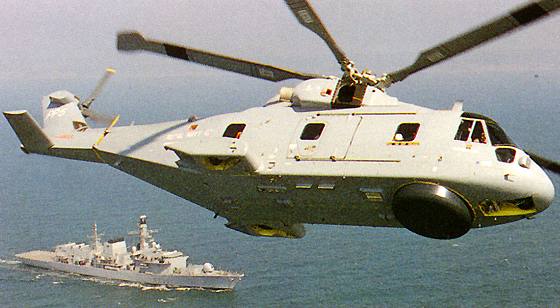
That was scary moment no. 2. Sighs of relief doesn’t really do justice to the relief that we had after that. But, the scariest moment was yet to come.
What made this last incident funny, was the R/T that followed. This was pretty much the conversation that ensued AFTER that incident.
Newcastle Radar :- Merlin Helicopter, we have a Robinson Light Helicopter who has just appeared on our radar in your vicinity.
Merlin Helicopter :- Yes, we have seen the helicopter, I think we gave it quite a fright.
Steve and I were laughing. They would have had the shits put up them JUST as much as we had !
Even though this moment was hairy, it didn’t really phase us too much, at this point, we were starting to discuss putting down in a field somewhere as our real concern was the weather. We were SOOOO close to Newcastle, but it just seemed to be getting worse and worse. If you’re reading this blog entry, you might recall a recent flight where the weather at Newcastle was gorgeous and everywhere APART FROM Newcastle seemed to be having horrible weather. This time it was the reverse, it seemed that Newcastle was the epicentre of the bad weather, but we only know this in hindsight. The ATIS (a radio service telling us the weather), was saying the weather at Newcastle was ok to proceed. No LVPs (low visibility procedures) were in force. LVPs would have stopped us going any further.
So, we push on, and as we do, we seemed to be skirting cloud more and more at lower and lower heights above the ground. But, we were still in sight of the surface and clear of cloud, although, AT TIMES, lower than we would have liked. We were having to fly slower so that we could avoid pylons if they appeared. I was back on the flying at this point and followed the A69 all the way to the A1. As we approached the A1, it seemed to be improving, and we were both a little relieved ! We were able to fly at 500 feet, and at 50-60kts. As we turned north, following the A1, we were 2 miles from the airport and within sniffing distance of a cup of coffee.
Scary Moment 3.
Suddenly, from following the A1 by sight at about 400 feet, we could see virtually nothing. We had entered cloud. We could JUST make out ground beneath us, but not the detail of the ground. It was quite frightening. For the first time, I was anxious and I could hear same in Steve’s voice.
Steve :- This isn’t good.
dp :- Let’s just do a 180′ and pick up the A1 again
Steve took over the flying and really took command…….
Steve :- Full Carb Heat (we had entered cloud, therefore more moisture in the air, more chance of carb icing)
dp :- Full Carb Heat Set
He then flew a 180′ on the instruments and to our great relief, 20 seconds later, we could see the surface again. Within a further 20 seconds, we saw a green patch of land and there was no doubt that we had to put down. Steve landed us next to the A1 and a housing estate at Blakelaw. Steve got out as soon as we were down to stop the inevitable crowd of onlookers from endangering themselves by approaching this weird flying thing that doesn’t normally land on their grass next to their houses. He also rang the flying school, while I shut the heli down.
Suffice to say, in Steve’s words….
Steve :- David, we’ve shared a special moment together up there
I knew exactly what he meant. He need say no more.
Once the copter was shut down, I got out and we chatted about what we could have done differently. Things like this happen in aviation. I had similar experiences in my microlighting days. Sh+t happens. The most important thing is to learn from those experiences and work out what we could have done differently.
What did we learn ? Well, the weather at Newcastle (when we left and a good part of the way there) was ok for us to approach and land safely. But the trend was a bad one, it was getting worse and worse.
At the same time, we were getting closer and closer. And so, you get this “nearly there, nearly made it” kind of mental attitude. In hindsight, we should have paid more attention to the trend and less attention to how close we were. That’s what we learned. Would we do the same again ? I am 100% confident that neither of us would let the situation get so bad in the future.
We were down on the ground, and we were safe. Or so we thought…… 
It turns out Blakelaw isn’t the most safest place from a crime perspective to park a £100k helicopter.
Before the blades had even stopped turning, people were coming from everywhere. It was just before the schools finished for the day, so once they were done, we were bombarded from all angles with school kids of all ages. Then the parents, passers-by etc etc….
If I had a 1p for every time someone asked one of these questions…..
Question 1 – Why have you landed here ?
Question 2 – When are you taking off ?
Question 3 – How fast does it go ?
Question 4 – Is it yours ?
etc etc….To be fair, even though Blakelaw might not have the lowest crime rate in the Tyne region, everyone who approached was friendly, but we did have to keep our eye on the kids.
At one point, when it was pouring down, Steve and I took shelter in the helicopter. All of a sudden, the helicopter starts bouncing up and down. Some kids were at the back of the copter, pulling down on the stinger (a black bar to stop the rotor hitting the ground).
We both jumped out and “asked” them not to do that. After that we were a bit more attentive.
So, very friendly people, but quite a few of them warned us NOT to keep the helicopter there over night, as it would be on bricks the following morning.
One bloke who lived in a nearby house, offered us the use of his bathroom and brought out some coffee for us, which was lovely and welcome. But where was the BRANDY !?!?!??!
About an hour after we had landed, Scott came out, and then a little later, the big boss Neil came out and we pretty much spent the whole afternoon (from 2.50pm until about 8pm) standing in the rain considering options. Discussed were taking off and flying 200 metres to the local car dealership and asking them to put it inside, or the local bus depot. But, after visits to both, they weren’t viable options.
So, it was left as waiting for the best visibility possible and then Scott and Steve took off and flew the final 2 miles to Newcastle, with me driving back in Scott’s wife’s car.
It was good we had all made it back in one piece.
So, a memorable day (to say the least). A VERY valuable one to me (and Steve probably) from a learning perspective. My first solo faded to insignificance from a learning perspective, but I didn’t mind. Flying a helicopter on your own is easier than with Steve’s weight on board anyway. He weighs a LOT ! 
It wasn’t just us affected by the weather. I had recently got in touch with an old friend from my RAF days (Hamish Mitchell) (http://www.scotlandonfloats.com/). He is an Air Traffic Controller for the upper airways, but also runs a floatplane company in Scotland. He was flying from Norfolk back upto Scotland with his floatplane and we had arranged to meet at Kielder Reservoir, where he was going to land and we were going to have a cup of something and catch up. But, Kielder refused him permission to land, so we were going to meet up at Carlisle airport instead. But, by the time he was as far north as Carlisle, the weather had got so bad, he had to fly to the west of the Lake District and from the email I got, he was pleased to be back home too !!
So, an incredibly interesting, exciting and valuable day. The kind of day, money can’t buy and one I’ll never forget.
Roll on the next flying lesson !
Here’s a piccy of where we landed at Blakelaw. Note the visibility.
